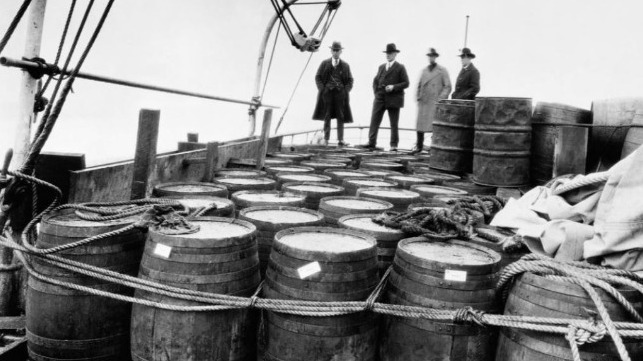The Cutter Daphne and the “North Atlantic Vegetable War”

[By Cmdr. William A. McKinstry, United States Coast Guard]
As the crew of the Ganeff [sic] told it, they were anchored on Rum Row Sunday night when the Daphne swung alongside. Suddenly a storm of paint pots, vegetables and other missiles came flying at them from the Coast Guard cutter . . . . - The Baltimore Sun, June 16, 1932
As the years of Prohibition came to a close, Coast Guard Cutter Daphne engaged in one of the most unique battles in the annals of the United States Coast Guard. Reported in the Baltimore Sun and many other newspapers, the “North Atlantic Vegetable War” proved the most unique tactic used to combat the rum runners during Prohibition.
While on patrol in the North Atlantic on Wednesday, June 15, 1932, the newly-commissioned 165-foot “B”-Class cutter Daphne, came upon the Newfoundland registered vessel Gonniff approximately 80 miles east of New York. Suspecting the Gonniff of smuggling contraband liquor, Daphne performed the usual tactic of calling the vessel to heave to so the cutter could conduct an inspection. However, this is where the story took a unique turn.

Newspaper image of Daphne during Prohibition law enforcement period. (News Review Newspaper, November 1936)
According to the men on board the Gonniff, Daphne’s gun crews and food service personnel mustered on the cutter’s deck. The Coast Guardsmen proceeded to shower the Gonniff with a smattering of paint, eggs, potatoes and produce before finishing off their first salvo by spraying down the rum runner with its high-pressure fire hose. The crew of the Gonniff responded in kind, firing jars of molasses onto Daphne’s wooden teak decks ensuring a lot of work requiring the cutter’s crew to remove sticky mess from the decks.

A colorized photograph depicting Daphne sistercutter Thetis underway in moderate swell. (U.S. Coast Guard)
With the latest barrage from the Gonniff, the crew of the Daphne continued their onslaught by throwing everything but the kitchen sink at the men of the rum runner. However, the battle was far from one-sided, with the Chicago Tribune reporting “One coast guard officer was knocked out when he was hit on the head with a turnip.” After the flying turnip incapacitate Daphne’s officer, things got dicey. According to the Gonniff’s crew, that’s when the Daphne’s cuttermen began inserting nuts and bolts into their potato projectiles.This enraged the crew of the Gonniff, which had had enough of the vegetable battle, broke off the engagement and tried to escape the cutter.
Daphne got underway, chased the Gonniff and rammed it in the stern ensuring the vessel had to abort its rum-running mission. The damaged Gonniff had to shift its cargo of liquor in order to assure its stability. It was assisted by sistership Mary F. Ruth, which, a few days previous, had a similar encounter with the Daphne, save the vegetable barrage. Both mother ships worked together aligning their cargoes for the return trip to Canada as Daphne stood by and prevented them from calling at a U.S. port. After a day or so, both ships limped into Halifax and the story of their encounter hit the Associated Press wires to worldwide amusement and outrage.

A mothership sailing offshore with a load of illegal liquor. (U.S. Coast Guard)
The Canadian Government was displeased that the Coast Guard treated two of its ships in such a manner. The Canadian Secretary of State sent a formal protest to the Coast Guard regarding the molestation of its shipping more than 50 miles at sea. The fact that the vessels were liquor carriers was well known by the Canadian Government, and that they were on their normal rum run when they were accosted. However, the fact that they were interdicted unnecessarily in the Canadians’ opinion created an international incident.
There are always two sides to a story. Capt. Randolph Ridgley, a senior officer at Coast Guard District One who read the report from Daphne’s commander, stated that the ramming of the rum runner was due to its laying down a smoke screen, dousing lights and zig-zagging to elude interdiction. Had it not used these suspicious tactics, the Coast Guard cutter would likely not been alerted to its presence and not interceded in such a fashion. Furthermore, Ridgely opined that good seamanship by the Daphne prevented more serious consequences to all involved.
With Prohibition ending within a year, this was one of the last incidents in what had been a wild time for the Coast Guard. This interdiction, like many others of the era, would showcase the innovativeness of Coast Guard crews, relying on skill, creativity and quick decision making, despite the lack of information at hand. In the end, the crew of the Daphne fulfilled its mission to ensure that illegal liquor did not reach U.S. soil.

A 1934 image of Coast Guard cutter Daphne guarding the prison barge for Al Capone on its short voyage to Alcatraz. (myalcaponemuseum.com)
In 1933, at the end of Prohibition, Daphne transferred to the West Coast, where the cutter served the remainder of its career. Before then, the cutter played a prominent role in the response to the crash of the Navy dirigible USS Akron, retrieving the remains of naval aviation pioneer, Rear Adm. William Moffett, from the waters of the Atlantic. In the mid-1930s, the cutter deployed on Bering Sea patrols and interdicted illegal narcotics in the San Francisco Bay Area. Daphne also escorted gangster Al Capone’s high-security barge to Alcatraz Prison in San Francisco Bay and secured the Port of San Francisco during World War II.
Coast Guard cutter Daphne decommissioned in 1946. The cutter was involved in many important missions during its service career. However, none of those missions compare to the uniqueness of the 1932 North Atlantic Vegetable War.
This article appears courtesy of Coast Guard Compass and may be found in its original form here.
The opinions expressed herein are the author's and not necessarily those of The Maritime Executive.
